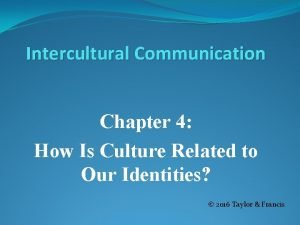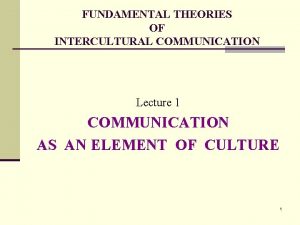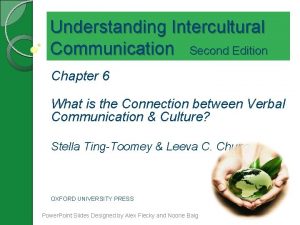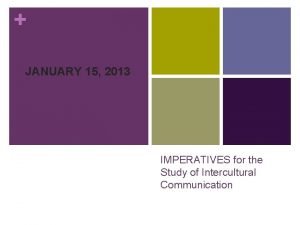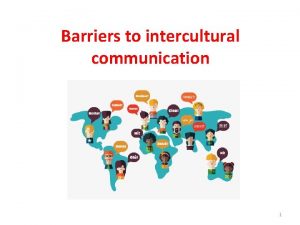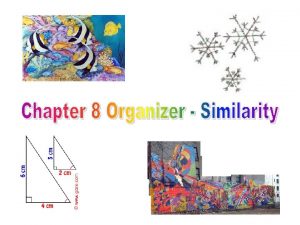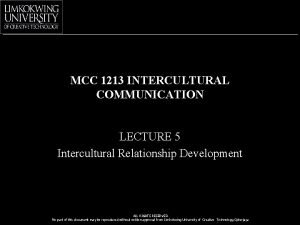Intercultural Communication Processing Our Experiment How similar or

























- Slides: 25

Intercultural Communication

Processing Our Experiment • How similar or dissimilar were you and each of your partners? • For Part 1 and Part 2: – What did you learn about your partner and his or her group? – How did you feel about your partner and his or her group? – Was the information you received about your partner correct?

The True Information You Received about Yourself A’s and D’s B’s and C’s • You are openly energetic • You are calm around others • You are (emotional, unemotional, or emotionally • You are (open-minded, -balanced) opinionated, or apathetic)

Part 1: The Stereotyped Information You Received about Your Partner A’s are hostile B’s are lazy A’s are hysterical B’s are judgmental C’s are lazy D’s are hostile C’s are judgmental D’s are hysterical

Part 2: The Information You Received about Your Partner Assume equality with A’s; You have no other information Assume equality with B’s; You have no other information Assume equality with C’s; You have no other information Assume equality with D’s; You have no other information

• Intercultural sensitivity is necessary to effectively communicate with diverse groups. • Intercultural sensitivity involves: • Self-esteem • Self-monitoring • Open-mindedness • Empathy • Interaction involvement • Suspending judgment • Using stereotypes makes communication with diverse groups problematic • Stereotypes resist alteration and can lead to prejudice and discrimination • Stereotypes create a barrier between us and others

Communication should be approached at both the individual and the cultural level. • “Emphasizing differences can lead to stereotyping and prejudice…Emphasizing only similarities may lead us to ignore the important cultural variations that exist, ” (Martin & Nakayama, 2000, p. 46) • “Groups are made up of individuals with unique as well as similar voices, ” (Collier, 2000, p. 24).

Communication from a Cultural Perspective Only is Insufficient • “We should not expect any group to use a particular communication style all the time, ” (p. 159). • When “we assume knowledge about another person’s identity, based on his of her membership in a particular cultural group…we are ignoring the individual aspect, ” (p. 141).

Communication from an Individual Perspective Only is Insufficient • You may overemphasize similarities, and see others more like yourself. • You may judge others by your own cultural standards, rather than considering other cultural standards.


Intercultural Communication – (Continued)

Some Definitions to Start Us Off… • Culture: “that set of values, beliefs, norms, customs, rules, and codes that socially define groups of people, giving them a sense of commonality. ” -- Race -- Gender -- Disability -- Ethnicity -- Religion -- SES -- Age -- Sexual Orientation -- Etc. • In-Groups and Out-Groups • Co-cultures: “The perception of membership in a group that is part of an encompassing culture. • Intercultural Communication: “The process that occurs when members of two or more cultures exchange messages in a manner that is influenced by their different cultural perceptions and symbol systems. ”

Cultural Values and Norms

High-Context vs. Low-Context • How much is communicated by the context, and how much needs to be directly said? Low Context Swiss, Germans, Scandinavians High Context European. Americans Self-Expression Valued African-Americans, Native Americans, Hispanic-Americans, Asian-Americans Japanese, Chinese Relational Harmony Valued

*Individualism vs. Collectivism* • Individualistic Cultures – Loyalty to self – Define self based on what you do – Value autonomy, change, youth, individual security, equality – Examples: • US, Canada, Australia, Great Britain • Collectivistic Cultures – Loyalty to family, community, work, etc. – Define self based on who your in-group is – Value duty, order, tradition, age, group security, status, hierarchy, relationship – Examples: • Latin American and Asian cultures

Power Difference • More egalitarian vs. more hierarchical? Low power deferential Austria, Denmark, Israel, New Zealand US, Canada High power deferential Philippines, Mexico, Venezuela, India, Singapore

Uncertainty Avoidance • “The degree to which members of a culture feel threatened by ambiguous situations and how much they try to avoid them. ” • Low Uncertainty Avoidance: – Tolerates or values nonconformity • High Uncertainty Avoidance: – Threatened by ambiguous situations/nonconformity – Values security – Clearly defined rules and regulations

Achievement vs. Nurturing Achievement Culture Nurturing Culture “Hard” “Soft” “Masculine” “Feminine” Material success/Goal-oriented Relationship-oriented Strict gender roles More gender neutrality Japan, Switzerland, Germany Norway, Sweden, Denmark, Spain, France

The Interplay Between Culture and Verbal & Nonverbal Codes

Verbal Codes • Language and Identity • Verbal Communication Style – Directness – Elaborateness/Succinctness – Formality/Informality • Language and Worldview – Linguistic Determinism – language determines worldview • Sapir-Whorf hypothesis: “the structure of a language affects the perceptions of reality of its speakers and thus influences their thought patterns and worldviews. ” – Linguistic Relativism – language strongly influences perceptions

Nonverbal Codes • Some nonverbals have universal meanings (e. g. , smiles, crying) • Others are more culturally-determined – Gestures – Proxemics – Chronemics – Eye-contact

Decoding Messages Cross. Culturally • Translation • Attributions – We tend to judge others’ behaviors less generously and according to our own cultural norms. – Stereotyping • Cultural Systems of Logic – Linear/Rational or Intuitive – Dichotomous or Nondichotomous

Developing Greater Intercultural Communication Competence

Intercultural Competence • Motivation and attitude – Tolerating ambiguity – Being open-minded • Not being ethnocentric • Not being prejudiced • Not stereotyping

• Knowledge of how other cultures communicate & skill in creating and responding to messages effectively – Mindfulness – awareness of one’s own behavior and that of others • Passive observation • Active strategies • Self-disclosure – Learn about who in a culture especially receives respect, and how this is communicated – Learn about how interactions are managed (the flow of conversation, turn-taking, etc. ) – Learn about roles, rules, and expectations for goalaccomplishment (e. g. , business), and for relationships
 Barriers in intercultural communication
Barriers in intercultural communication Intercultural communication meaning
Intercultural communication meaning Intercultural communication questions
Intercultural communication questions Ascription and avowal
Ascription and avowal Youtube intercultural communication
Youtube intercultural communication Intercultural communication notes
Intercultural communication notes Staircase model of intercultural communication
Staircase model of intercultural communication Example of verbal intercultural communication
Example of verbal intercultural communication Nonverbal intercultural communication
Nonverbal intercultural communication Intercultural communication conclusion
Intercultural communication conclusion Ethnocentrism intercultural communication
Ethnocentrism intercultural communication Intercultural communication model
Intercultural communication model Technology and intercultural communication
Technology and intercultural communication The totality of a groups thought experiences and patterns
The totality of a groups thought experiences and patterns Strategies for improving intercultural communication
Strategies for improving intercultural communication Understanding intercultural communication 2nd edition
Understanding intercultural communication 2nd edition Intercultural communication in contexts
Intercultural communication in contexts Demographic imperative intercultural communication
Demographic imperative intercultural communication 4 barriers of intercultural communication
4 barriers of intercultural communication Similar disuelve a similar
Similar disuelve a similar Propiedades fisicoquímicas del agua
Propiedades fisicoquímicas del agua Similar
Similar Precipitancy creates prodigality
Precipitancy creates prodigality Thinking affects our language which then affects our
Thinking affects our language which then affects our Our census our future
Our census our future Longing for peace our world is troubled
Longing for peace our world is troubled



